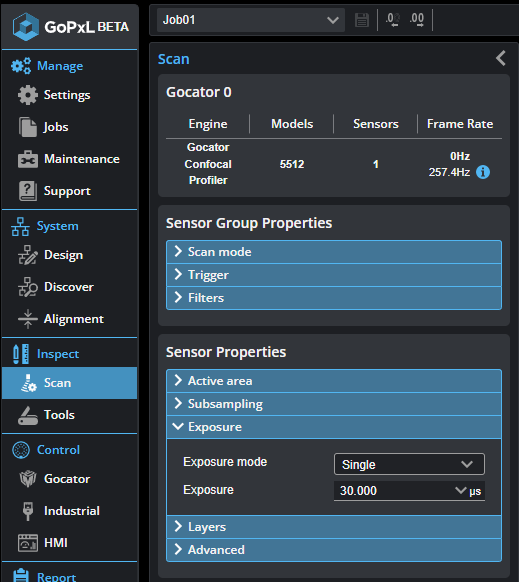Exposure and Light Intensity
Exposure determines the duration of camera and light-source on-time (or pulse width), given in microseconds (µs). Longer exposures can be helpful to detect light on dark or distant surfaces, but increasing exposure time decreases the maximum speed. Different target surfaces may require different exposures for optimal results. In general, shiny and mirror-like surfaces require a short pulse width and low-gloss surfaces a high pulse width.
Sensors provide two or three exposure modes, depending on the model, for the flexibility needed to scan different types of target surfaces.
Adjust the exposure in Image mode. Set the scan mode to Image, capture some scan data, and hover the pointer on top of the profile to see the intensity value. Check the whole profile length of interest. It is very important that in the active measurement area the image is not saturated. Intensity value range is from 0 to 255, it is recommended to keep the maximum intensity below 240.
To properly set exposure, you can acquire scan data in Image mode, and examine the resulting image to confirm whether the features or flaws you need to measure will be well presented in the scan data. For more information on Image mode and the information it provides for configuring exposure, see Image Mode.
You configure exposure in the Exposure panel on the Inspect > Scan page, in the Sensor Properties section.


|
When exposure is set to Dynamic or Multiple, additional parameters are displayed. |
| Exposure Mode | Description |
|---|---|
| Single | Uses a single exposure duration for each frame. |
| Dynamic | Automatically adjusts the exposure after each frame based on an analysis of the preceding frame. Used when the target surface varies between scans. For more information, see Dynamic Exposure. |
| Multiple | Uses multiple exposures to create a single profile. Used when the target surface has a varying reflectance within a single profile. For more information, see Multiple Exposure. |